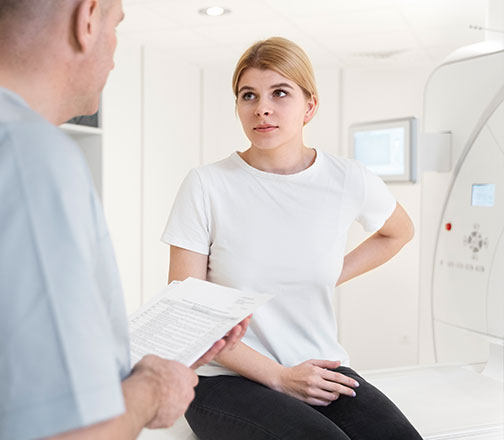 +1-855-573-2663
+1-855-573-2663
 support@secondopinions.com
support@secondopinions.com
 Sep 10, 2024
Sep 10, 2024


1 in 8 women, or approximately 13% of the female population in the United States, will be diagnosed with breast cancer in her lifetime. In 2024, an estimated 310,720 women will be diagnosed with invasive breast cancer, as well as 56,500 new cases of non-invasive breast cancer1.
Mammograms have long been the standard bearer for breast cancer screening, but breast MRIs are emerging as a vital tool because it offers a more detailed view of breast tissue.
Breast MRIs are particularly valuable for certain groups of women, like those with a high risk for breast cancer, those with a strong family history or genetic predisposition (like BRCA1 or BRCA2 mutations), dense breast tissue, or those who previously hadf breast cancer. The American College of Radiology recommends women with 20% or greater lifetime risk of developing breast cancer be screened annually with MRI. In some situations, breast MRIs (magnetic field imaging) can help clarify mammogram results that might be inconclusive2.
As noted above, if you have the BRCA 1 or 2 genetic mutations, you have a 60–85% cumulative lifetime risk of developing breast cancer and the sensitivity of MRI for the detection of breast cancer in this high-risk population ranges from 75–100%. Studies have demonstrated that in BRCA positive women, 44.7% of cancers are not detectable with mammography and are detected with MRI3. The robust data obtained with numerous studies investigating the use of screening breast MRI in women with markedly increased risk of breast cancer demonstrates that annual screening with MRI detects earlier and more likely curable breast cancer.
Even if your are BRCA negtive, a breast MRI will be recommended if you have been diagnosed with breast cancer, or your doctor believes that you have breast cancer based on your mammogram and/or breast ultrasound. Breast MRI imaging, in addition to traditional tissue-sampling that provides biomarkers, offers a complementary, noninvasive method to obtain biological information about breast cancer.
Breast MRIs are used for preoperative staging to assess the extent of the disease and to optimize treatment strategies. Your breast surgical and treatment plan will be based on these MRIs because they provide critical information that delineate the extent of the primary tumor and metastases. Studies have demonstrated that when women with newly diagnosed breast cancer are evaluated with MRI, additional foci of disease are identified in 10% of women4.
There are 4 different types of magnectic field imaging: MRIs, diffuse weighted imaging (DWI), magnetic resonance elastography (MRE), and magnetic resonance spectroscopy (MRS). All are different imaging methods used in the diagnosis of breast cancer that could help clarify your diagnosis, the type of tumor you might have, and fine-tune your treatment.
MRIs are considered less painful than mammograms because they don’t involve breast compression. Patients receive an IV, and then are positioning face down on a table. The table slides into the MRI machine and during the procedure, a contrast die is adminsitrered. The entire procedure lasts around 25-30 minutes. Radiologists analyze the images and share the results with the patient’s doctor.
MRI imaging is more sensitive than mammography and ultrasound in the diagnosis of breast cancer and it is relatively cost-effective. Studies have shown that MRI has detected 14.7 new cases of cancer per 1000 people when used as a complementary method in people who have already had mammography and ultrasound5.
Detailed images of MRIs provide comprehensive views of the breast tissue. In 2017, a meta-analysis compared and analyzed the sensitivity and specificity of MRI imaging techniques with mammography. Results of 11 previous studies showed that MRI and mammogram sensitivity were 92% and 75%, respectively, and their specificity was 71% and 70%6.
Finally, unlike mammograms, MRI does not use ionizing radiation, making it a safer option for women who require frequent screening.
While breast MRIs offer significant benefits, it is not without misconceptions.
The procedure has been found to be relatively cost effective, but on the whole, breast MRIs are more expensive than mammograms, and not all insurance plans cover it. Check with your insurance company to make sure you are covered.
MRIs are highly sensitive tests which can lead to false positives, identifying benign conditions as potential cancer. This can result in unnecessary biopsies and anxiety.
Finally, not all medical facilities have MRI machines specifically designed for breast imaging and you might need to travel to specialized centers for the procedure and find expert, experienced, and accredited radiologists to review the results.
Breast (MRI) quality may vary across the United States. Studies have shown that more than two-thirds of breast MRI studies subjected to second-opinion review had at least one technical deficiency. Sixty (68%) of cases had at least one technical deficiency. In 11% of cases, more than five different technical deficiencies occurred7. Nearly 70% of physicians at affiliated specialty breast care centers have indicated that their practice performed “outside study interpretations” of breast imaging8, which tends to show that second-opinion interpretations for breast imaging has added value.
Over the past two decades, the death rate from breast cancer has decreased substantially due to the combination of improved detection as well as improved, increasingly targeted therapies. When breast cancer is detected early, over 91% of all women survive more than five years9. The detection and treatment of an earlier breast cancer is not only associated with improved outcome, but also with less aggressive therapy and less extensive surgery. Therefore, it is critical that every woman has the optimal chance at detection of early, curable breast cancer.
And curable breast cancer starts with a second opinion.

Our website content is posted for informational purposes only. It is not intended to be used for primary diagnoses-making and should not replace a consultation with a professional health care provider. If you have any health issues or complaints, please consult your primary physician. Healthcare data provided for informational purposes is not an alternative to an in-person physician consultation.